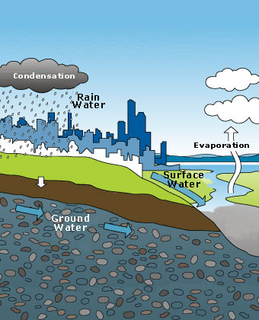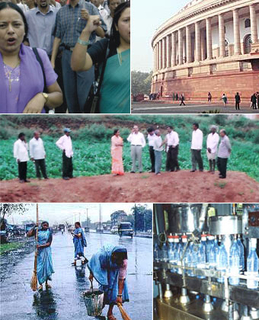“Urban Waters” served as a background material for Arghyam’s second annual conference on April 2007 at Bangalore. There is a vast body of research on urban water issues; a bewildering number of organizations are working on the subject; and it has a wide array of dimensions. This overview seeks to present a snapshot, as simple and clear a picture of this totality as is possible while attempting to retain enough detail for it to be of interest and use as a starting point for discussion. The focus here is on India, while the larger field of vision is the developing world and then, beyond that, the world itself.
Some of the key questions being addressed here:
- What are the central facts of India’s urban water situation?
- What are the specific problems of our cities and towns?
- Who are the stakeholders in this picture?
- What are the equity issues?
- What is the legal framework?
- What are our current and projected requirements?
- What examples and best practices can we draw on from India and around the world?
Overview
Due to rise in economy and increase in migration to cities there is tremendous increase in water demand in recent years and this is bound to grow in times to come.
Piped water systems have been setup by the Government in most cities. But large percent of semi- urban areas are not covered and rely on ground water. Piped sewerage systems feeding into large treatment plants exist only in bigger cities & metros.
Most cities have septic tanks or local waste management. In most of urban India, the poor constitute about 30% and are left out of the bulk water network.
A fact sheet
- 85% of India’s urban population has access to drinking water but only 20% of the available drinking water meets health and safety standards
- As per 2001 census, 27.78% of India's population lives in urban areas. It is estimated that by the year 2020, 40% of India’s population will be living in urban areas and will face acute water problems
- Furthermore, there are serious inequities in the distribution of water. Consumption of water ranges from 16 liters per day to 3 liters per day depending on the city and the economic strata of the Indian consumer.
An analysis on urban water
- In 35 urban centres in India, representing 15 per cent of the urban population, water is supplied on average for 6.9 hours per day
- The quantity of water produced is reported to be 145 litres per capita per day.
- By 1999-2000, 90 per cent of urban population is reported to have access to safe drinking water
An analysis of information from water suppliers in 35 urban centres in India, representing 15 per cent of the urban population (city populations ranging from 17,600 up to 10,300,000) indicates that water is supplied on average for 6.9 hours per day to a claimed 84 per cent of the urban population.
- The quantity of water produced is reported to be 145 litres per capita per day. With an average 26 per cent unaccounted for water, this gives an idealised 107 litres per capita per day water consumed. But these average figures hide dramatic variations where unaccounted for water is more likely to be in the range of 40 to 60 percent with some low-income consumers receiving only 16 litres per capita during a one hour supply period. (INDIA: URBAN WATER SUPPLY, Richard Franceys, IHE, Delft, Kevin Sansom, WEDC, Loughborough.)
- By 1999-2000, 90 per cent of urban population is reported to have access to safe drinking water. However, there are severe deficiencies with regard to quality of water available to urban residents. The target level of water supply as fixed by the National Drinking Water Mission in the late 1980's was 140 LPCD for cities and 40 LPCD for slums. The same was to be achieved by Year 2000. As against this target, actual availability of drinking water in covered households varies from 165LPCD for class 1 cities to 54 LPCD for class-IV cities and the average availability of water in slums is 27 LPCD.
The urban water cycle

The urban water cycle involves storage and distribution, treatment, recycling, disposal, the protection, conservation and exploitation of water resources at their
origin.
The urban water cycle includes:
- Rainwater
- Desalination
- Ground and surface water
Integrated urban water resource management is an emerging area of learning and research.
Stakeholders

- Government
- Water departments/boards
- Lake authorities
- Municipal corporations
- Citizen groups
- Private sector entrepreneurs*
- Water tanker
- Bottled water suppliers
*Reasons for rapid growth of private sector:
This rapid growth is due to an increase in purchasing power and an awareness of the hygienic dimension of water and the necessity of a viable supply (bore well service providers, industries, urban poor).
Key Issues
Following are the key water issues faced by the urban centers:
- Surveys have revealed that 61 per cent of the surface water supply sources for cities of population greater than 0.1 million are highly contaminated. Nearly 46 per cent of urban population has water sealed toilets, but only 28 per cent are connected to the public sewerage system. There is, thus, a major lacuna in the provision water and sanitation services.
- Lack of planning for urban watersheds that lead to flooding.
- Unaccounted water supply rates as high as 30% in many cities. This is due to following factors:
- Irrational tariffs
- Lack of metering
- Financially non-viable
- Urban water planning does not cater to the needs of the urban poor.
- Cost recovery is poor primarily because of the institutional setup of the WSS sector. The depts.., boards or municipal corporations responsible for the supply, distribution and conservation of water sources are isolated. They are also financially weak and lack competent man-power. Very political issue so tariffs remain low.
Drying water sources
Water sources like rivers and lakes are drying due to encroachment, construction, roads. No regulation of ground water extraction, high usage and wastage, low incentive for conservation due to misdirected subsidies.
Poor quality of water
Following factors account for poor quality of water:
- Pollution
- inadequate source protection
- storm-water drains carrying sewage
- poor management of wastes
Lack of industrial water management
Following factors demonstrate the lack of industrial water management:
- Pollution caused by waste water
- Lack of reuse of water
- Poor regulation of wastewater disposal
- High tariffs
Industries that face high tariffs exit from the system leading to reduced revenues. Results in additional costs to consumers from costly strategies (digging tube wells, installing electric pumps and constructing reservoirs, drawing unauthorized connections, etc.) to offset the meager supply whether households are connected or not. Moreover, the poorest households pay more in proportion to their income than the well-off households. Worst hit are the slum-dwellers who have to rely on multiple sources, consume much below the recommended levels (27 lpcd from one study in Delhi) and can pay several times the amount the rich do Rs 100 to Rs 135 per month per family (Zérah and Llorente 1999).
Conflict Areas
- Anti-privatization
- Rural agricultural needs vs. urban domestic needs
- Appropriation of rural water sources for urban areas
- Industry’s use of ground water from rural areas
- Lake encroachment for construction
Scientific, technological and socio-economic solutions
The Planning Commission estimates that, to make up the huge backlog in the Water Supply and Sewerage sector in the next 10, years, investments of about 15,000 crore per annum would be required.
Government approach to manage urban water by:
- Privatizing distribution of water and sanitation services
- Enabling the private sector to provide financial, managerial and technical knowledge to improve distribution systems
- Ensuring internal augmentation of water resources
- Encouraging the local authorities to augment water sources by reducing UFW and recycling & reuse regulation
- Ensuring water conservation through an appropriate tariff structure.
- Introducing rational pricing and user tariffs based on metered supply to promote conservation
Suggestions from NGO sector regarding urban water issues
The Jal Biradari 2004 had the following suggestions from the NGO sector regarding urban water issues –
- Urban centers should rely on local water to avoid impacting rural areas;
- Urban centers should use techniques like RWH and recycling/reuse;
- Urban centers need publicity & awareness campaigns on water conservation;
- Polluter pays principle should be applied to urban users;
- Cost of water should include cost of treatment and disposal too;
- Tariffs should be revised to keep the basin minimum free and charge beyond this based on capacity and usage;
- Ground water markets should be reigned in and GW should be regulated;
- Pollution control laws should be implemented properly to prevent GW pollution which travels up the food chain through the crops;
- Communities should be given control over their water resources.
To view the full course in flash presentation please click
To read more about urban water scenario please click
/articles/course-urban-water-scenario